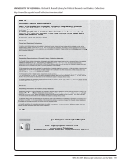92 · Survey Results: Survey Questions and Responses
Formats of finding aids vary widely —
created over time by various individuals
and at different times. Rather than
re-doing them, the library digitizes what
is already in existence.
No database system to manage the
finding aids. Time consuming to update
the Web site—changes have to be
made across multiple pages.
Too few staff to process incoming
material.
Inadequate resources to process
collections and create finding aids.
Inadequate staffing and department-
wide training. Standardization suffers
when description and encoding is left
up to student assistants who have only
minimal in-house training in either.
With only one full-time professional
in the Special Collections Library, very
little direct supervision can be provided.
The two staff members who aid in
supervising the students have not had
any training in EAD and processing
beyond in-house training. Also, the
turnover rate for these assistants is
high, further hindering efforts for
standardization.
Lack of existing descriptive information.
We have nearly 2000 manuscript
collections that have very little (to no)
existing descriptive information. The
only information that exists in many
cases is a brief card catalog record.
In some cases, this record does not
contain the “basics” needed to create
a more full record (date ranges, creator
name, etc.). This means that additional
research is required to create a finding
aid that can be included with the
others.
Increasing number of descriptive tools
and descriptive content to maintain.
Lack of full implementation of a content
management system and temporary
loss of certain functionalities associated
with the new Arizona Archives Online
site.
Growth of collections and reassignment
of staff to duties in other departments.
Lack of external funding opportunities
for this work.
Indexing. Transcribing the text of the manuscripts
so that the text can be OCR indexed &
searched by the end user.
Having the right equipment and the
best process.
Labor. Training.
Lack of IT support.
Lack of staff. Lack of a professional archivist on staff.
Lack of staff. Inadequate intellectual control of
collections.
No decision on standards.
Lack of standardization in legacy
finding aids.
Time to create specifications for vendors
to convert unusual finding aids.
Cost of outsourcing encoding.
Lack of standardization of legacy
finding aids.
Some key information not in legacy
finding aids, e.g., biography/history
notes or scope notes.
Legacy finding aids are detailed to the
item level.
Formats of finding aids vary widely —
created over time by various individuals
and at different times. Rather than
re-doing them, the library digitizes what
is already in existence.
No database system to manage the
finding aids. Time consuming to update
the Web site—changes have to be
made across multiple pages.
Too few staff to process incoming
material.
Inadequate resources to process
collections and create finding aids.
Inadequate staffing and department-
wide training. Standardization suffers
when description and encoding is left
up to student assistants who have only
minimal in-house training in either.
With only one full-time professional
in the Special Collections Library, very
little direct supervision can be provided.
The two staff members who aid in
supervising the students have not had
any training in EAD and processing
beyond in-house training. Also, the
turnover rate for these assistants is
high, further hindering efforts for
standardization.
Lack of existing descriptive information.
We have nearly 2000 manuscript
collections that have very little (to no)
existing descriptive information. The
only information that exists in many
cases is a brief card catalog record.
In some cases, this record does not
contain the “basics” needed to create
a more full record (date ranges, creator
name, etc.). This means that additional
research is required to create a finding
aid that can be included with the
others.
Increasing number of descriptive tools
and descriptive content to maintain.
Lack of full implementation of a content
management system and temporary
loss of certain functionalities associated
with the new Arizona Archives Online
site.
Growth of collections and reassignment
of staff to duties in other departments.
Lack of external funding opportunities
for this work.
Indexing. Transcribing the text of the manuscripts
so that the text can be OCR indexed &
searched by the end user.
Having the right equipment and the
best process.
Labor. Training.
Lack of IT support.
Lack of staff. Lack of a professional archivist on staff.
Lack of staff. Inadequate intellectual control of
collections.
No decision on standards.
Lack of standardization in legacy
finding aids.
Time to create specifications for vendors
to convert unusual finding aids.
Cost of outsourcing encoding.
Lack of standardization of legacy
finding aids.
Some key information not in legacy
finding aids, e.g., biography/history
notes or scope notes.
Legacy finding aids are detailed to the
item level.








































































































































































































